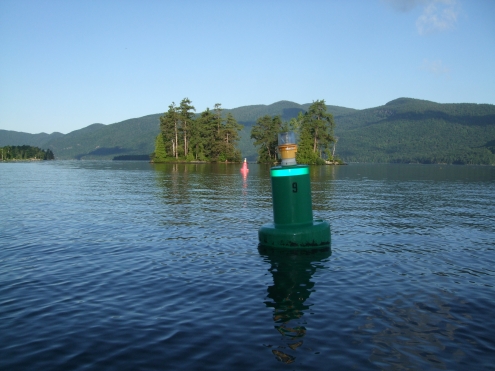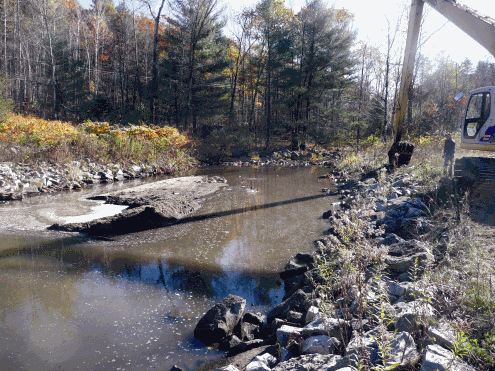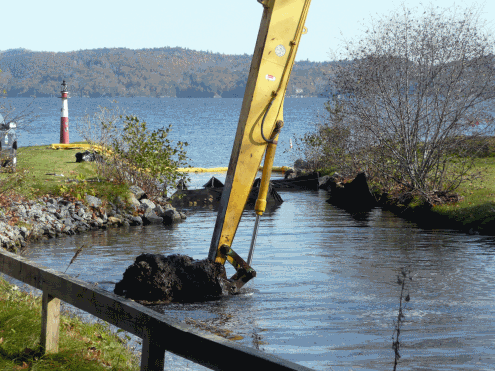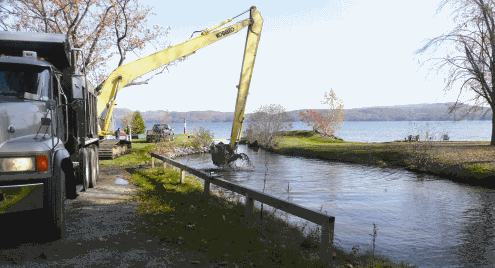Courtesy of the Lake George Association
httpv://www.youtube.com/watch?v=T_N5sXgbDxE&list=UUM-C-6iAH-MdI6g8xPM2mVA&index=1&feature=plcp

News & Opinion About Huletts Landing, N.Y.
Courtesy of the Lake George Association
httpv://www.youtube.com/watch?v=T_N5sXgbDxE&list=UUM-C-6iAH-MdI6g8xPM2mVA&index=1&feature=plcp

Over 30 people, including many children, enjoyed having the Lake George Association’s Floating classroom stop in Huletts in 2011.
I’m pleased to announce that the Lake George Association’s Floating Classroom, will return to Huletts on Friday, July 20th at 1:00 pm, courtesy of the Friends of Historic Huletts Landing who is sponsoring this event.
A donation will be required to help defray the cost but I’ll have more specifics as the date draws closer.
So if you missed the excursion last summer, please plan on attending the trip in 2012!
(Click on image to see full-scale.)

So you love looking at old photographs of Huletts Landing and Lake George, but you thought you had seen them all.
Well the #1 reason to read The Hulett Hotel Fire on Lake George, is that it contains a treasure trove of pictures, published together for the first time, of Huletts Landing and Lake George. Some of these pictures have their own mysterious origins that you will want read about!
To see these unique pictures, you’ll definitively want to buy:
The Hulett Hotel Fire on Lake George.
Pre-order the book here and you’ll have it as soon as it is released.

Don’t we all grow by learning new things? Isn’t learning imaginatively enriching? Well, if you want to learn something new about something old, while capturing your imagination in new ways, you’ll definitely want to read the The Hulett Hotel Fire on Lake George.
The book includes almost two years of research, so I can confidently say that you’ll enjoy turning every page. I was able to unearth some incredible historical documents, which I was originally convinced were lost, that are real eye openers.
Whether you love history or just the Lake George region, you’ll learn plenty of new things when you read The Hulett Hotel Fire on Lake George.
To learn about my research, you’ll definitively want to buy:
The Hulett Hotel Fire on Lake George.
Pre-order the book here and you’ll have it as soon as it is released.

There’s an old saying that says in effect; “the people make the place.”
Well a hundred years ago is a long time though, and history sometimes forgets the people “that made the place.”
One of things I enjoyed while writing, The Hulett Hotel Fire on Lake George was researching the many interesting characters that the book encompasses.
Would you like to know about the tragic, fatal accident that the District Attorney was involved in roughly a year before the arson trial started? Would you like to know which participant in the trial had a relative who went on to win the Nobel Peace Prize? Want to learn which witness had trouble testifying about their own name?
To learn the answers to these and many other interesting questions you’ll definitively want to buy:
The Hulett Hotel Fire on Lake George.
Pre-order the book here and you’ll have it as soon as it is released.

Do you like a good story? How about a good mystery?
Well you’ll read a really great story and find a mystery in a mystery in the book;
The Hulett Hotel Fire on Lake George.
A mystery in a mystery? You’re probably asking; “What’s he talking about?”
Well, I can’t give it away, you’ll have to read the book. What I can tell you is that as I delved deeper into the story, the material was quite rich and very interesting. So rich in fact, I can say that you will thoroughly enjoy it!
To learn more, you’ll definitively want to buy:
The Hulett Hotel Fire on Lake George.
Pre-order the book here and you’ll have it as soon as it is released.

Did you know that the Hulett Hotel Fire of 1915 was one of the largest fires ever on the shores of Lake George?
In chapter five of The Hulett Hotel Fire on Lake George you’ll learn what happened on that day in 1915 when the fire occurred.
You’ll see the only known photographs of the two people who discovered the fire, and you’ll learn how the unique weather conditions that day made extinguishing the fire almost impossible. You’ll also learn how many other houses the fire spread to and what happened to those cottages on that fateful day!
To learn more about these interesting events, you’ll want to buy:
The Hulett Hotel Fire on Lake George.
Pre-order the book here and you’ll have it as soon as it is released.

I’m happy to unveil the cover of my new book:
The Hulett Hotel Fire on Lake George.
On a clear November day in 1915, the Hulett Hotel on Lake George caught fire and burned to the ground. Quickly rebuilt, the “new” Hulett became a popular tourist destination. However, after the rebuilding, a mysterious figure claimed that the hotel’s owner, William H. Wyatt, had paid him to start the fire and a sensational arson trial followed.
Now you can read about these strange happenings in vivid detail, including the testimony offered at the trial and never before seen photographs which have their own mysterious origins.
You’ll also read about Wyatt’s other hotel on nearby Lake Bomoseen, Vermont that burned down in 1912 and see unique pictures of that hotel on fire. You’ll view never before seen photographs of the ashes of the burned Hulett Hotel and construction of the new Hulett Hotel. And you’ll learn about the trial that followed.
“The Hulett Hotel Fire on Lake George” will be released in mid-February but can be pre-ordered starting today from History Press.
The book can be ordered here from the publisher.
What better thing to do on a cold winter day than read a great book about the Huletts Landing fire of 1915 and the arson trial that followed.
I will continue this entire week with the top reasons why you will want to add this book to your collection!
 Over the past year and a half, my writing on this site has been off a bit because I have been working on a very special project.
Over the past year and a half, my writing on this site has been off a bit because I have been working on a very special project.
I am now happy to announce ….. drum roll………. that my second book is officially complete and headed to the presses!!!
So on Monday, January 9, 2012 I will announce here on the Huletts Current, the title of the book, tell you something about it, and do a public unveiling of the cover.
You will have to wait a few more days but the book has something to do with ………….. you guessed it ………. Huletts Landing and Lake George!!
I’ve spent the last year compiling some exquisite and quite rare photographs, and researching a topic which I guarantee all lovers of Huletts and Lake George history will find interesting. This past year has brought me to some very interesting places while I’ve researched this book.
So stop back on Monday, January 9, 2012 to learn more about: what the new book is about, the publisher and the release date. You’ll get a preview of the cover as an added bonus!
During the week following Monday, January 9th, I’ll be posting some of the top reasons why you’ll want to purchase this book.
This is one volume that everyone will want to have on their bookcase. You’ll see it here on the Huletts Current for the first time on Monday, January 9, 2012.

The water off of Huletts Landing was measured to be some of the clearest water in the lake in 2011.
Lake George received the best reading on a measurement for clarity among 98 New York lakes in 2011, the Lake George Association announced today.
“If you want clear water in New York State, Gull Bay on Lake George is the place to be!” said Nancy Mueller, the manager of the NYS Federation of Lake Associations, Inc., the organization sponsoring New York’s Citizens Statewide Lake Assessment Program (CSLAP), in conjunction with the NYS Department of Environmental Conservation. On Lake George, the program has been coordinated by the Lake George Association for the past eight years.
Peter Leyh, an LGA member, was one of several 2011 volunteers to participate in CSLAP. Peter sampled water near Gull Bay on the north end of the lake, and sank a measuring disk for clarity, called a Secchi disk, into the lake. He was able to see the disk in the water at a depth of 11.3 meters on July 5, and he recorded a reading of 11.35 meters on August 22. Both times Peter was able to see the Secchi disk at a depth a little over 37 feet. On August 7, LGA CSLAP volunteers Jack and Cathy LaBombard, who were testing the water near Huletts Landing, recording a reading of 11.24 meters. No other lake participating in the CSLAP program this year could match these readings.
“The rainy, stormy weather had most of the readings across the state down this year– so it was nice to have a few double digit readings. They were hard to come by,” said Mueller.
Readings taken by participants on the LGA’s Floating Classroom showed similar results. “We had some good days on trips for students in the north end of the Lake, and the readings we took near Roger’s Rock were probably close to Peter’s,” said Kristen Rohne, LGA watershed educator.
“While this is great news for Lake George,” said Walt Lender, LGA executive director, “it by no means allows us to relax our efforts to protect the Lake and keep it clean. In fact, it means just the opposite. People need to know that all of these exceptionally clear readings were taken at the north end of the Lake on a perfectly calm day. The clarity and cleanliness in the south end of Lake George, near West Brook, is not anywhere close to this. We have seen a disturbing trend in loss of water clarity and quality from south to north. ”
“This helps keep things in perspective for us,” said Emily DeBolt, LGA director of education. “Yes – lake George is facing many threats – but it is still exceptionally clear, and we are exceptionally lucky. We still have time to work together to protect it and keep it this way for years to come! The key is acting now before it really truly is too late,” she said.
Every summer since 2004, the Lake George Association has coordinated volunteers to assess water quality and clarity through the CSLAP program. The data gathered is used to help manage and assess trends in New York’s many lakes. In addition to CSLAP, the Lake George Association actively encourages adults and children to learn more about lake monitoring and stewardship aboard its Floating Classroom, a specially equipped catamaran which takes groups out on the Lake from May through September.
NY Times: Adirondacks Warming?
The NY Times follows Jerry Jenkins, an ecologist with the Wildlife Conservation Society.
Hard frosts that a generation ago came in mid-September now arrive in October. Lake Champlain, a huge freshwater body that divides New York and Vermont, once froze over completely every winter, but now remains open in the middle some years.
Groups Look at Lake George Dredging Differently
The Post Star describes the debate.
Cell Service Almost Complete for Lake George
The Lake George Mirror reports that the entire basin has almost complete coverage.
Old Ticonderoga Hospital to Get New Use
The Press Republican reports on the old Moses-Ludington Hospital.
Teddy Roosevelt’s Home Set for Rehab
Yahoo and the AP take a look Roosevelt’s classic home.
Popular Ti Restaurant Closes
The Times of Ti reports on the closing of the Carillon Restaurant.
Lake George Rock Climbing Gets National Exposure
The Lake George Mirror tells us about Paddle to Crag on Lake George.
Saranac Lake Community Store Profiled in NY Times
The hearty residents of Saranac Lake started their own store and made the NY Times.
Cash Coming In from Trash Plant Going
The Post Star reports that Washington county will receive a windfall because we no longer have the trash plant to operate.
 The Lake George Association has constructed a new sediment pond at English Brook. The pond is designed to capture hundreds of tons of sediment before it enters Lake George.
The Lake George Association has constructed a new sediment pond at English Brook. The pond is designed to capture hundreds of tons of sediment before it enters Lake George.
The Lake George Association has completed the construction of a new sediment basin at the mouth of English Brook in the town of Lake George at the southern end of the lake. Construction was completed during the last week of October. The 150-foot long sediment basin was designed by the Warren County Soil and Water Conservation District (WCSWCD) with financial assistance from the LGA. The basin will slow down the flow of water and allow sediment to fall out prior to entering the Lake. Grass pavers were also installed to enable future access to the site so that it can be maintained. The basin will be cleaned out every one to two years, when it reaches about 50-75% capacity. Each time it is cleaned out, roughly 300-400 cubic yards of material will be removed.
After Tropical Storm Irene, English Brook changed its route near its mouth: it started flowing in the same path that it did nearly 50 years ago, prior to the construction of the Northway. The last 300 feet of the brook now flows in a northeasterly direction. After input from the NYS Department of Environmental Conservation (DEC), it was determined that the stream should remain in place and the basin installed where the stream is currently flowing.

This picture, taken in November 2010, shows the path that English brook took before Tropical Storm Irene and the delta forming in Lake George.
In the aftermath of Tropical Storm Irene, WCSWCD used funds provided by the DEC to pull out trees, remediate the streambank and recreate capacity in the brook. The remainder of these funds will be used to complete more of the projects outlined in a WSCSCD 2008 English Brook Watershed Study, and the LGA will provide supplemental funding for these where possible.
English Brook is one of eight major brooks flowing into Lake George. “LGA lake saving projects make a huge difference to water quality, because stormwater runoff is the number one source of pollutants entering Lake George,” said Randy Rath, LGA project manager.
Since the construction of the Northway, the shoreline near the mouth of English Brook has moved significantly. A cottage that was once right on the lake now sits several hundred yards back. The DEC lists the brook as sediment impaired, and its delta is one of the largest on Lake George. According to National Urban Runoff Program reports conducted during the 1980s, English Brook has high levels of total phosphorus, chlorides, total suspended sediments, lead and nitrate-nitrogen.

Dave Wick, executive director of the Warren County Soil and Water Conservation District, stands at the current Lake George shoreline near the mouth of English Brook, and looks back at a cottage that was located at the water’s edge some 50 years ago. Construction of the Northway increased the amount of sediment carried downstream and caused the location of the shoreline to change significantly.
English Brook is located just north of Lake George Village at the Lochlea Estate. Earlier this summer, the LGA installed a $49,500 Aqua-Swirl stormwater separator on the property, as part of a $100,000 stormwater project. This system is collecting previously untreated stormwater runoff from both the east and west sides of Rt. 9N, as well as the bridge between the two exits at Exit 22 on Interstate 87. The majority of the runoff in a 48-acre subwatershed is now being captured and treated.
Further upstream, at the Hubble Reservoir, the LGA hired Galusha Construction to remove a non-functioning sluice gate and valve that were making it difficult to maintain the site. The site was dewatered and almost 600 cubic yards of sediment were removed in 2009. This reservoir is slated for cleaning again in 2012. The LGA acquired funding for all of the English Brook projects through grants from the Helen V. Froehlich Foundation and the New York State Department of State and the Environmental Protection Fund, with additional funding for the Aqua-Swirl project provided by the Lake Champlain Basin Program.
Now that much of the needed upland work is complete, the culminating lake saving step for English Brook is to remove the sediment that has built up in the delta in Lake George over the course of generations. The nutrient-rich sediment in deltas supports invasive plant growth, hampers fish spawning, and harbors nuisance waterfowl. By removing the delta, safe navigation is restored, the health of the Lake’s fisheries improves, the Lake returns to its original bottom, and property values are retained.

Last week, crews cleaned out the sediment that has built up in a retention basin on Hague Brook. This pond on the upper part of the brook was originally constructed by the LGA in 2006. Over 45 dump trucks full of material was removed from two different retention basins on the brook.
This past week, three sediment basins in Hague were cleaned out: two on Hague Brook, and a third at the mouth of Jenkins Brook. The project was a team effort by the Lake George Association, Warren County Soil and Water Conservation District, and the town of Hague. Over 1100 cubic yards of material was removed from the three sites.
“These basins are instrumental to maintaining high water quality in Lake George,” said LGA executive director Walt Lender. “We began constructing the basins several years ago, and now every one to two years we go in to clean them out. The LGA provides project support and partial funding for the construction projects as well as funding to help maintain the sites,” he added.
Approximately $5,000 of the $8,000 Hague clean-outs has been funded by the LGA, with in-kind management and project oversite by the Warren County Soil & Water Conservation District, and in-kind hauling services provided by the town of Hague. “The town of Hague realizes the importance of maintaining the basins and the health of Lake George. We were happy to contribute to the project,” said Hague Town Supervisor Dan Belden.

A long-reach excavator removes sediment from a retention basin at the mouth of Jenkins Brook.

From the upper basin on Hague Brook, crews removed 530 cubic yards of material, or roughly 31 dump trucks full. On the lower basin on Hague Brook, 285 cubic yards of material was removed, equating to roughly 16 dump trucks full. At Jenkins Brook, 345 cubic yards of sediment was removed, roughly 20 dump trucks full. Morrissey Construction provided trucking services and an operator for the long reach excavator, and Services Unlimited also provided trucking services.
Beginning in the early 1990s, an active program of utilizing upland in-stream sediment basins to capture sediment began in Warren County, spearheaded by the Warren County Soil & Water Conservation District (WCSWCD). Old reservoirs were cleaned out and new in-stream sediment basins were created. By slowing stream velocity, basins allow sediment to drop out of suspension and be captured by the basin prior to reaching Lake George.